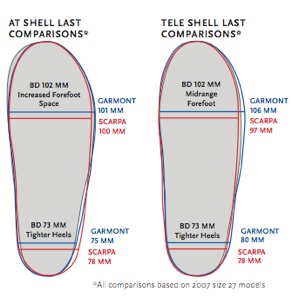NTN Fit -
Garmont - medium volume and medium width - definitely narrower than 75 mm Garmont boots. Asymmetric bellows. Very form fitting with a pre-punched shell.
Crispi - different fit in the two models. The Evo is the narrowest NTN boot, moderate volume. The Evo Shiver is a medium width and volume boot more width than Garmont.
Scarpa - The highest volume and widest NTN boot. Asymmetric bellows.
In 75mm Scarpa is the narrowest and lowest volume, in NTN it is the widest and highest volume.
Shell Breaks -
The other thing to be aware of is the way the shells are sized. Generally the shells serve more than one size. For example in my boots the 28 and 28.5 share the same lower shell. This is typically printed on the inside of the shell and can be seen with the liner removed. So why do we care about this? Generally you want to be in as small a shell as possible so knowing where a manufacturer has his shell break means you can try to be in the high end of a given shell size so you have as little liner as possible. Manufacturers simply increase liner thickness in the smaller size to make up the volume, this leads to the possibility of more pack out. The shell breaks by manufacturer as far as I can tell are -
Garmont breaks on the 1/2 size so 28 and 28.5 share the same shell.
Cripsi breaks on the full size so 27.5 and 28 share the same shell.
Scarpa breaks on the full size so 27.5 and 28 share the same shell.
Black Diamond breaks on the 1/2 size so 28 and 28.5 share the same shell.
You can always check this by finding the shell size with the liner out (make sure you are looking at the lower shell the cuff is totally different and not really relevant).
The video with Paul and Mitch covers pretty much the same ground but you get to hear Paul talk about going to the outhouse and painting his toenails!
BTW you get extra credit if you correctly identify the boot in the header photo!
-
Larry White - Larry is a CANSI Telemark Instructor and Telemark Course Conductor and a CSIA Alpine instructor - Dec 2, 2008.
If you have feedback or useful suggestions email - bootfitting.
Dec 18, 2008 - added new first step - determining your foot size.
Nov 12, 2009 - updated shell fit information with BD info and added a section for 75 and NTN. Added information on thermoforming Garmont, Intuition & BD Liners.
Nov 16, 2009 - added info on the Garmont Voodoo and footbed sizing.


